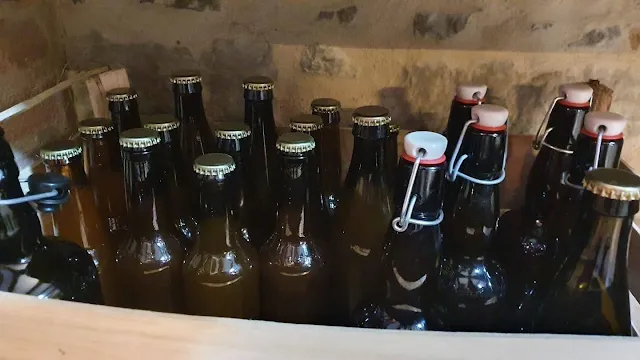What level of head space should I leave in the bottle neck for homebrew beer?
We found this.
For a given amount of priming sugar, the greater the headspace, the lower the carbonation." - some guy on the internet
Let's explore what they mean.
When bottling beer, leaving 1 to 1 ½ inches of headspace is quite the common standard practice.
Why does this happen?
Headspace tends to aid in preventing oxidation and exploding bottles due to unreleased C02 pressure.
Conversely, too much headspace may result in off-flavors.
So, you are looking for the Goldilocks level of headspace, something just right.
The science of it explains how there are practical effects on your beer.
The science of it explains how there are practical effects on your beer.
If you are leaving more headspace than you should in your bottle, the carbon dioxide produced by fermentation will not stay in the beer solution and will instead fill up the empty space in your bottle. The result then of too much headspace is that you may open the beer and get a comforting "psssst" sound but your beer could well be unintentionally under carbonated and taste somewhat flat.
Try to leave between 1/2" to 1" of headspace in your bottles when bottling.
Carbon dioxide is going to be produced in bottled beer because the yeasts will be feeding on the priming sugars in the brew. Having adequate headspace allows the gas somewhere to go.
Too much head space can cause a foul beer flavor.
So what's the ideal level of headspace for a beer?
Try to leave between 1/2" to 1" of headspace in your bottles when bottling.
Carbon dioxide is going to be produced in bottled beer because the yeasts will be feeding on the priming sugars in the brew. Having adequate headspace allows the gas somewhere to go.
Too much head space can cause a foul beer flavor.
Ever had a beer taste like cardboard!?
Why does this happen?
Yeast utilizes the oxygen in the bottle (meaning carbonation speeds up with bigger headspace), and any leftover oxygen results in too much air and this makes your beer taste terrible.
This is also why when bottling you should try to ensure a simple straight pour from the fermenter into the bottle - often achieved quite well
Indeed a bottling wand will help to achieve a consistently even level of headspace, When filling, you fill it to the very top of the bottle. When you remove the wand, the space left is quite the perfect amount of headspace - depending on your bottle size of course...
Another problem with having more headspace than needed is simply that you’ll end up needing more bottles since you’re underfilling them!
If you are using recyclable beer bottles, my personal choice is just to try and leave it at a leave that looks like what would have been the original pour from the manufacturer.
If you are really worried about oxygen in your beer you can also consider using oxygen caps.
No way.
Another problem with having more headspace than needed is simply that you’ll end up needing more bottles since you’re underfilling them!
If you are using recyclable beer bottles, my personal choice is just to try and leave it at a leave that looks like what would have been the original pour from the manufacturer.
If you are really worried about oxygen in your beer you can also consider using oxygen caps.
Should I forget headspace and fill the bottle to the very top?
No way.
Beer expands when allowed to warm up.
Expanding beer creates unimaginable pressure (surprisingly far more than overpriming) that will either break bottles or at least will cause leakage via the cap if it is not sealed quite firmly.
The amount of expansion will depend on how stable you keep your storage temperature.
Given this and we know that beer generally benefits from an apt amount of headspace, don't overfill your beer bottles.

0 comments:
Post a Comment